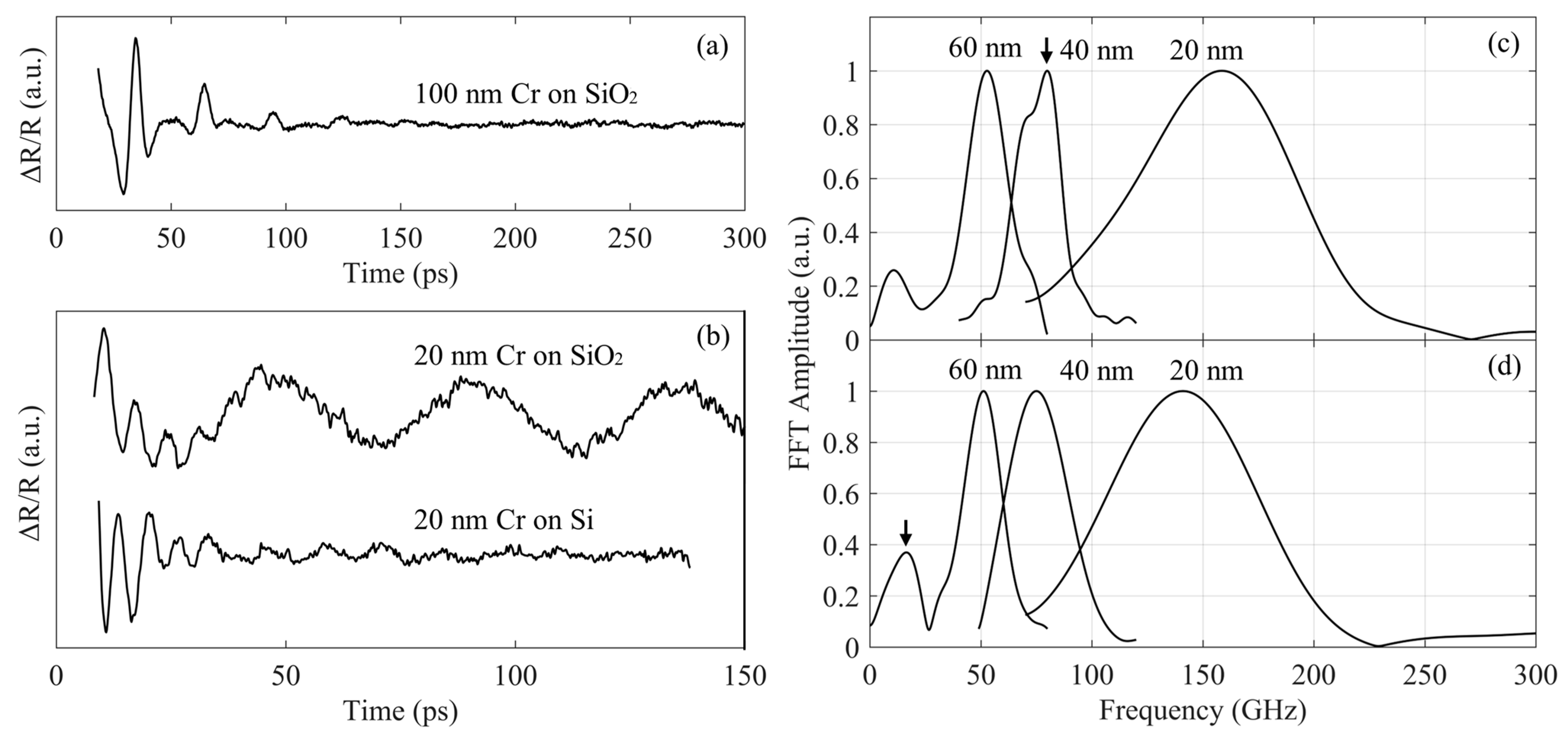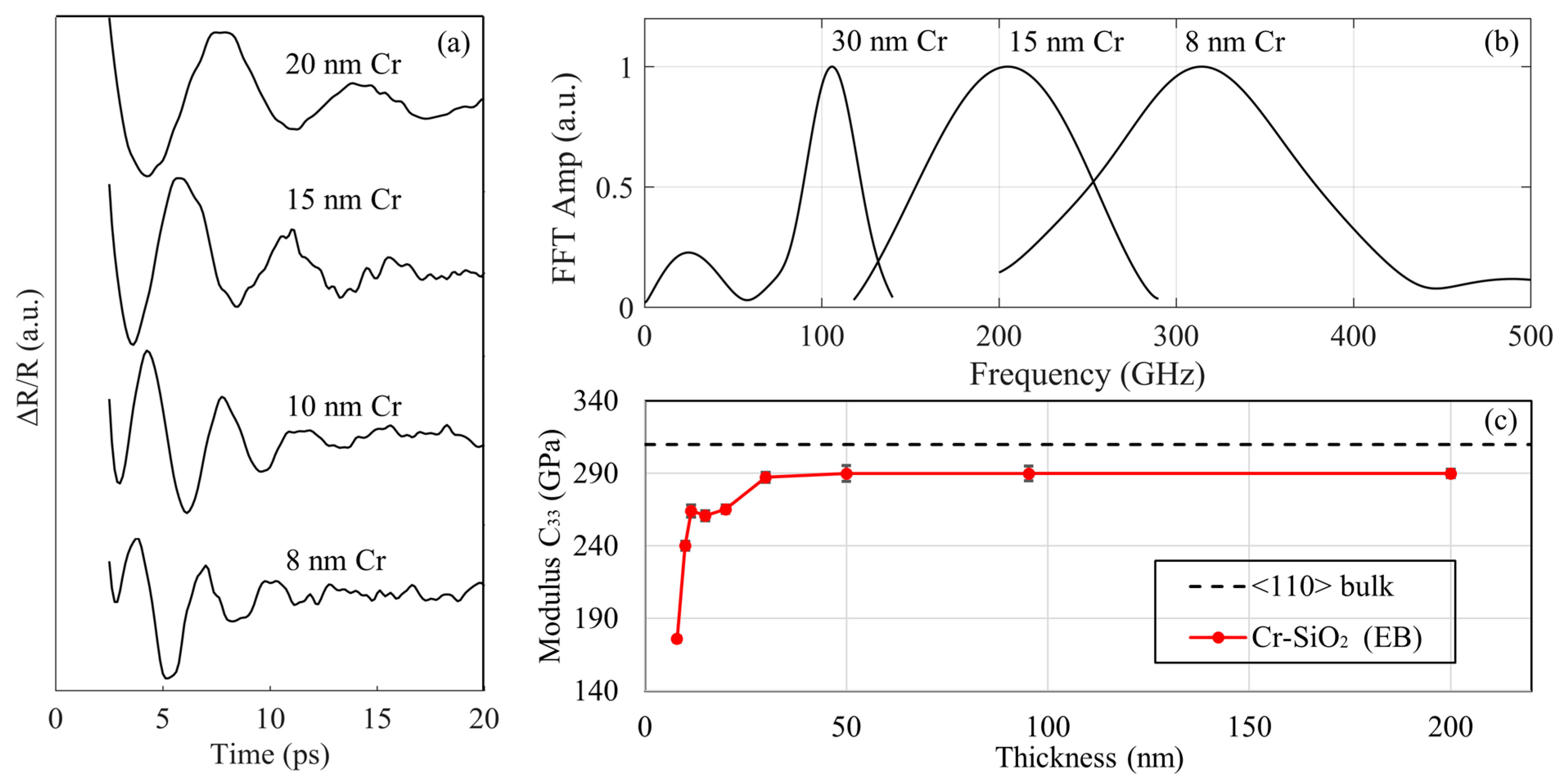Picosecond Ultrasonics for Studying Elastic Modulus of Polycrystalline Chromium Nanofilms: Thickness Dependence and Stiffness Enhancement
Abstract
1. Introduction
2. Materials and Methods
2.1. Sample Preparation
2.2. Picosecond Ultrasonics Method
2.2.1. Experimental Setup
2.2.2. Measurement Theory
2.2.3. Typical Acoustic Signals
3. Results
4. Discussion
5. Conclusions
Author Contributions
Funding
Institutional Review Board Statement
Informed Consent Statement
Data Availability Statement
Conflicts of Interest
References
- Balu, R.; Raju, A.R.; Lakshminarayanan, V.; Mohan, S. Investigations on the influence of process parameters on the structural evolution of ion beam sputter deposited chromium thin films. Mater. Sci. Eng. B 2005, 123, 7–12. [Google Scholar] [CrossRef]
- Ezer, Y.; Härkönen, J.; Sokolov, V.; Saarilahti, J.; Kaitila, J.; Kuivalainen, P. Diffusion barrier performance of thin Cr films in the Cu/Cr/Si structure. Mater. Res. Bull. 1998, 33, 1331–1337. [Google Scholar] [CrossRef]
- Wang, Z.Y.; Hu, E.T.; Cai, Q.Y.; Wang, J.; Wei, W. Accurate Design of Solar Selective Absorber Based on Measured Optical Constants of Nano-thin Cr Film. Coatings 2021, 10, 938. [Google Scholar] [CrossRef]
- Msa, B.; Ss, A.; Mm, C.; Smid, E.; Wo, A.; Aa, B. Fabrication and Characterization of Au/Cr and Cr/Au Multilayered Plasmonic Nanofilms for Sensing Applications. J. Mater. Res. Technol. 2021, 11, 1868–1880. [Google Scholar]
- Sytchkova, A.; Belosludtsev, A.; Volosevičienė, L.; Juškėnas, R.; Simniškis, R. Optical, structural and electrical properties of sputtered ultrathin chromium films. Opt. Mater. 2021, 121, 111530. [Google Scholar] [CrossRef]
- Nilsson, S.; Borrise, X.; Montelius, L. Size effect on Young’s modulus of thin chromium cantilevers. Appl. Phys. Lett. 2004, 85, 3555–3557. [Google Scholar] [CrossRef]
- Thomsen, C.; Grahn, H.T.; Maris, H.J.; Tauc, J. Surface generation and detection of phonons by picosecond light pulses. Phys. Rev. B 1986, 34, 4129–4138. [Google Scholar] [CrossRef] [PubMed]
- Matsuda, O.; Larciprete, M.C.; Voti, R.L.; Wright, O.B. Fundamentals of picosecond laser ultrasonics. Ultrasonics 2015, 56, 3–20. [Google Scholar] [CrossRef]
- Lee, S.; Kim, Y.Y.; Cho, Y. A Comparative Study on the Elastic Characteristics of an Aluminum Thin-Film Using Laser Optical Measurement Techniques. Coatings 2017, 7, 143. [Google Scholar] [CrossRef]
- Grossmann, M.; Klingele, M.; Scheel, P.; Ristow, O.; Hettich, M.; He, C.; Waitz, R.; Schubert, M.; Bruchhausen, A.; Gusev, V.; et al. Femtosecond spectroscopy of acoustic frequency combs in the 100-GHz frequency range in Al/Si membranes. Phys. Rev. B 2013, 88, 205202. [Google Scholar] [CrossRef]
- Daly, B.C.; Kang, K.; Wang, Y.; Cahill, D.G. Picosecond ultrasonic measurements of attenuation of longitudinal acoustic phonons in silicon. Phys. Rev. B 2009, 80, 174112. [Google Scholar] [CrossRef]
- Wang, P.-J.; Shen, C.-C.; Chou, K.-Y.; Ho, M.-H.; Sheu, J.-K.; Sun, C.-K. Studying time-dependent contribution of hot-electron versus lattice-induced thermal-expansion response in ultra-thin Au-nanofilms. Appl. Phys. Lett. 2020, 117, 154101. [Google Scholar] [CrossRef]
- Yu, K.; Devkota, T.; Beane, G.; Wang, G.P.; Hartland, G.V. Brillouin Oscillations from Single Au Nanoplate Opto-Acoustic Transducers. ACS Nano 2017, 11, 8064–8071. [Google Scholar] [CrossRef] [PubMed]
- Yan, S.; Dong, C.; Miao, T.; Wang, W.; Ma, W.; Zhang, X.; Kohno, M.; Takata, Y. Long delay time study of thermal transport and thermal stress in thin Pt film-glass substrate system by time-domain thermoreflectance measurements. Appl. Therm. Eng. 2017, 111, 1433–1440. [Google Scholar] [CrossRef]
- Ogi, H.; Fujii, M.; Nakamura, N.; Yasui, T.; Hirao, M. Stiffened ultrathin Pt films confirmed by acoustic-phonon resonances. Phys. Rev. Lett. 2007, 98, 195503. [Google Scholar] [CrossRef] [PubMed]
- Ogi, H.; Fujii, M.; Nakamura, N.; Shagawa, T.; Hirao, M. Resonance acoustic-phonon spectroscopy for studying elasticity of ultrathin films. Appl. Phys. Lett. 2007, 90, 191906. [Google Scholar] [CrossRef]
- Chou, K.-Y.; Wu, C.-L.; Shen, C.-C.; Sheu, J.-K.; Sun, C.-K. Terahertz Photoacoustic Generation Using Ultrathin Nickel Nanofilms. J. Phys. Chem. C 2021, 125, 3134–3142. [Google Scholar] [CrossRef]
- Saito, T.; Matsuda, O.; Wright, O.B. Picosecond acoustic phonon pulse generation in nickel and chromium. Phys. Rev. B 2003, 67, 920–925. [Google Scholar] [CrossRef]
- Tu, X.; Zeng, Y.; Wang, S.; Li, L.; Li, C.; Wang, Z. Comprehensive Characterization of Thermal and Mechanical Properties in Thin Metal Film-Glass Substrate System by Ultrafast Laser Pump-Probe Method. Opt. Express 2022, 30, 46193–46208. [Google Scholar] [CrossRef] [PubMed]
- Ogi, H.; Nakamura, N.; Hirao, M. Picosecond ultrasound spectroscopy for studying elastic modulus of thin films: A review. Nondestruct. Test. Eval. 2011, 26, 267–280. [Google Scholar] [CrossRef]
- Lejman, M.; Shalagatskyi, V.; Kovalenko, O.; Pezeril, T.; Temnov, V.V.; Ruello, P. Ultrafast optical detection of coherent acoustic phonons emission driven by superdiffusive hot electrons. J. Opt. Soc. Am. B Opt. Phys. 2014, 31, 282–290. [Google Scholar] [CrossRef]
- de Haan, G.; van den Hooven, T.J.; Planken, P.C.M. Ultrafast laser-induced strain waves in thin ruthenium layers. Opt. Express 2021, 29, 32051–32067. [Google Scholar] [CrossRef] [PubMed]
- Gusev, V.; Lomonosov, A.M.; Ruello, P.; Ayouch, A.; Vaudel, G. Depth-profiling of elastic and optical inhomogeneities in transparent materials by picosecond ultrasonic interferometry: Theory. J. Appl. Phys. 2011, 110, 124908. [Google Scholar] [CrossRef]
- Gusev, V.E.; Ruello, P. Advances in applications of time-domain Brillouin scattering for nanoscale imaging. Appl. Phys. Rev. 2018, 5, 031101. [Google Scholar] [CrossRef]
- Delmotte, F.; Meyer-Ilse, J.; Salmassi, F.; Soufli, R.; Burcklen, C.; Rebellato, J.; Jérome, A.; Vickridge, I.; Briand, E.; Gullikson, E. Soft X-ray optical constants of sputtered chromium thin films with improved accuracy in the L and M absorption edge regions. J. Appl. Phys. 2018, 124, 035107. [Google Scholar] [CrossRef]
- Nakamura, N.; Yokomura, R.; Takeuchi, N.; Yamakado, D.; Ogi, H. Elastic stiffness of metallic multilayers studied by picosecond ultrasonics: Improved interpretation of interface elasticity. Jpn. J. Appl. Phys. 2019, 58, 075504. [Google Scholar] [CrossRef]




Disclaimer/Publisher’s Note: The statements, opinions and data contained in all publications are solely those of the individual author(s) and contributor(s) and not of MDPI and/or the editor(s). MDPI and/or the editor(s) disclaim responsibility for any injury to people or property resulting from any ideas, methods, instructions or products referred to in the content. |
© 2023 by the authors. Licensee MDPI, Basel, Switzerland. This article is an open access article distributed under the terms and conditions of the Creative Commons Attribution (CC BY) license (https://creativecommons.org/licenses/by/4.0/).
Share and Cite
Tu, X.; Li, J.; Yan, J.; Wang, S.; Li, L.; Li, C.; Wang, Z. Picosecond Ultrasonics for Studying Elastic Modulus of Polycrystalline Chromium Nanofilms: Thickness Dependence and Stiffness Enhancement. Coatings 2023, 13, 438. https://doi.org/10.3390/coatings13020438
Tu X, Li J, Yan J, Wang S, Li L, Li C, Wang Z. Picosecond Ultrasonics for Studying Elastic Modulus of Polycrystalline Chromium Nanofilms: Thickness Dependence and Stiffness Enhancement. Coatings. 2023; 13(2):438. https://doi.org/10.3390/coatings13020438
Chicago/Turabian StyleTu, Xinhao, Jun Li, Jinyu Yan, Shibin Wang, Linan Li, Chuanwei Li, and Zhiyong Wang. 2023. "Picosecond Ultrasonics for Studying Elastic Modulus of Polycrystalline Chromium Nanofilms: Thickness Dependence and Stiffness Enhancement" Coatings 13, no. 2: 438. https://doi.org/10.3390/coatings13020438
APA StyleTu, X., Li, J., Yan, J., Wang, S., Li, L., Li, C., & Wang, Z. (2023). Picosecond Ultrasonics for Studying Elastic Modulus of Polycrystalline Chromium Nanofilms: Thickness Dependence and Stiffness Enhancement. Coatings, 13(2), 438. https://doi.org/10.3390/coatings13020438





